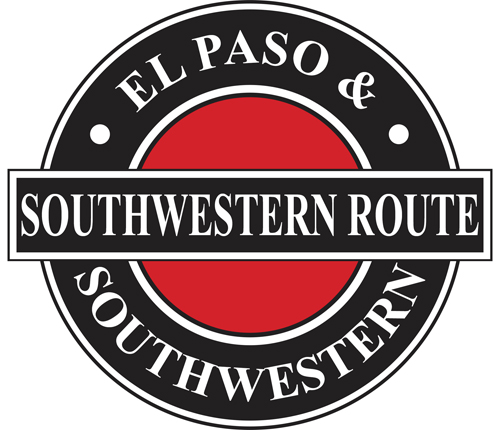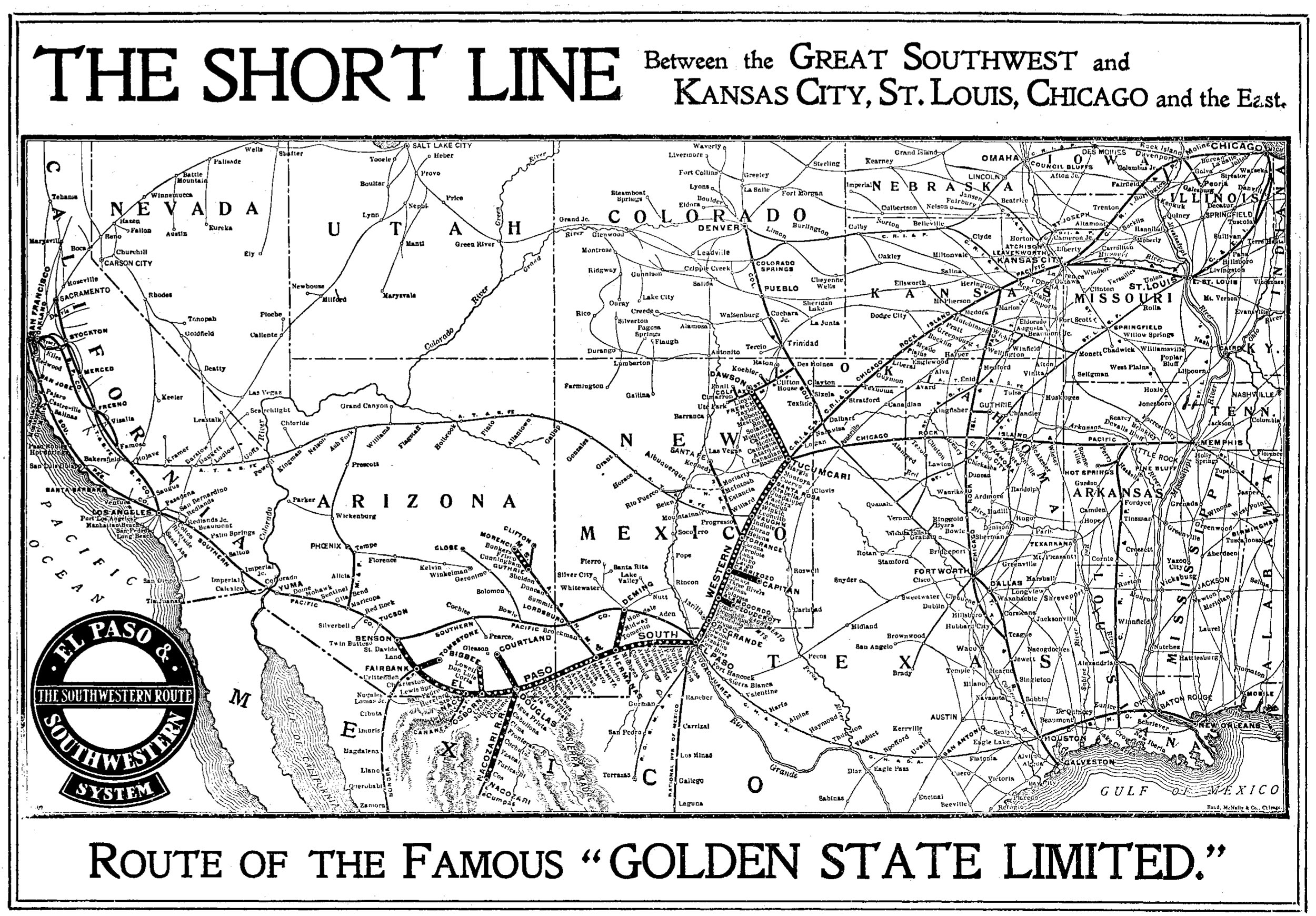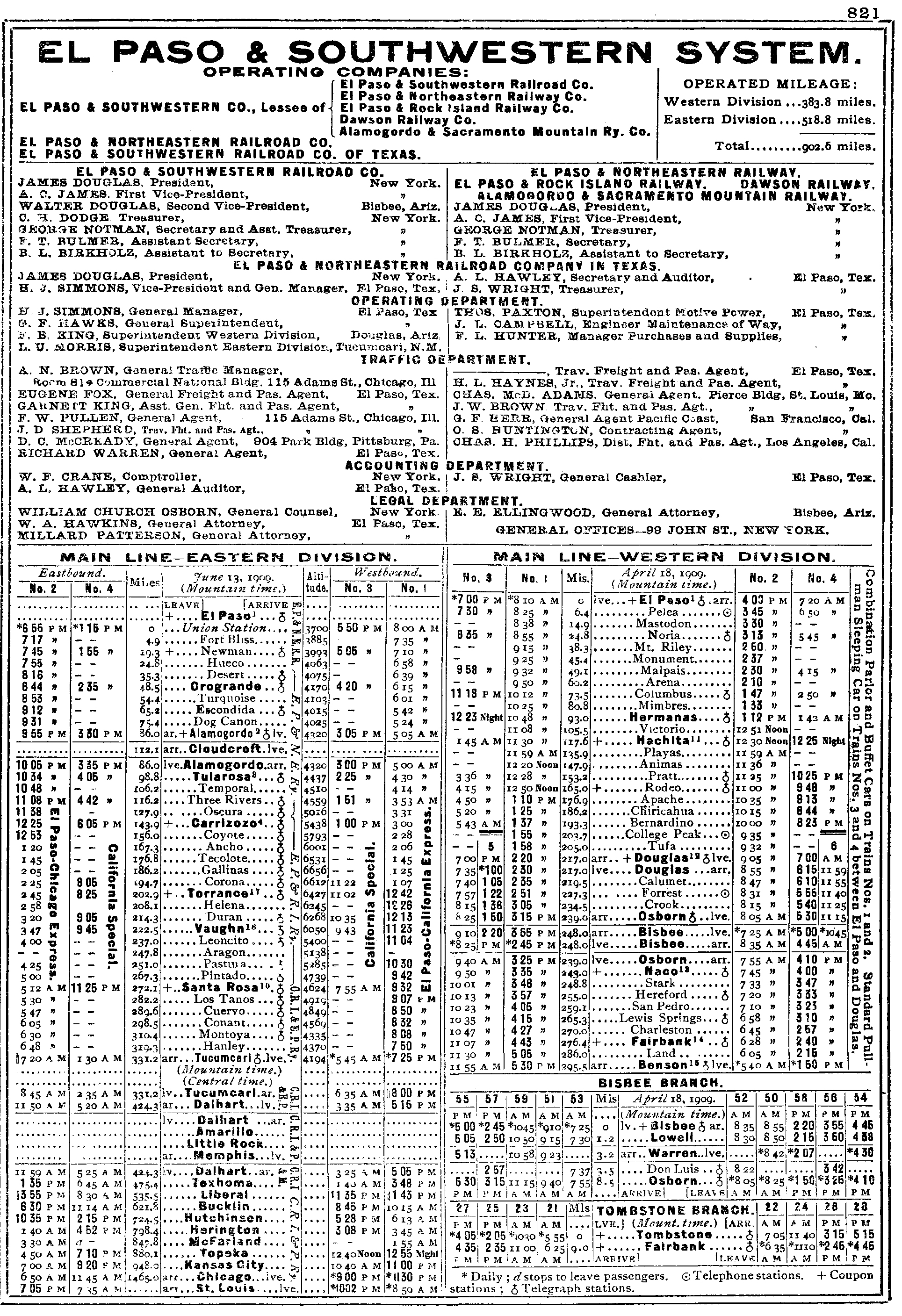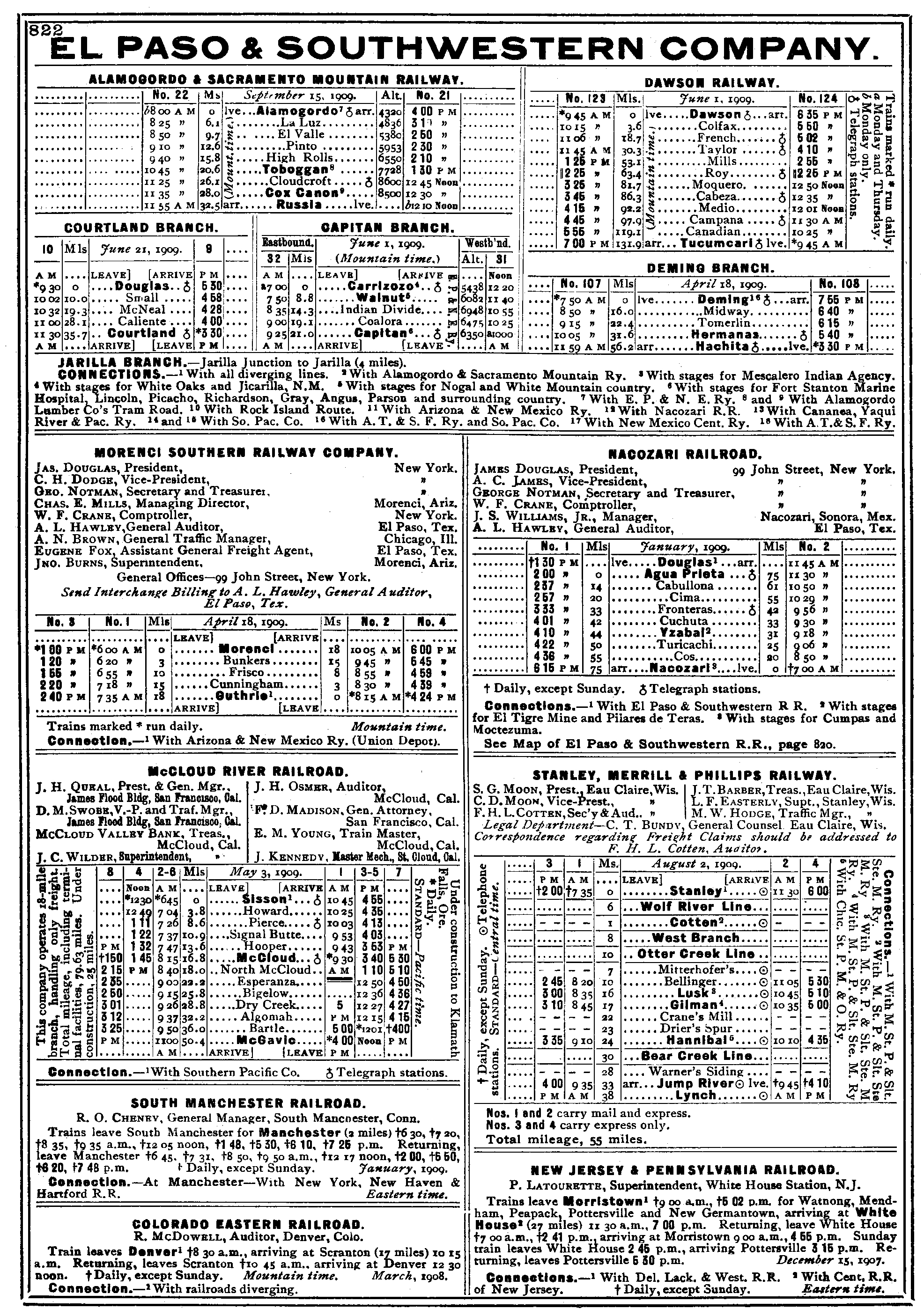El Paso & Southwestern Railroad: Map, History, Logo
Last revised: July 26, 2024
By: Adam Burns
Considering its once massive size the El Paso and Southwestern Railroad
is often completely forgotten as a large, Class I carrier that served
the desert region of the Southwest.
The EP&SW was established by copper interests, which felt that a railroad was the best way to move raw ore to their smelters and then on to market. With a strong financial backing the system continued to grow from its original founding in the late 1880s to serve the states of Arizona, New Mexico, and Texas as well as northern Mexico!
Despite its large size the EP&SW always relied heavily on copper as its major source of freight and when prices began to decline around World War I so too did the company's fortunes.
In the 1920s the road was picked up by Southern Pacific and eventually fully merged into its system by the early 1960s. Today, some sections of the EP&SW are still in operation although after SP ownership much of the railroad was abandoned or sold as traffic dried up.
Photos
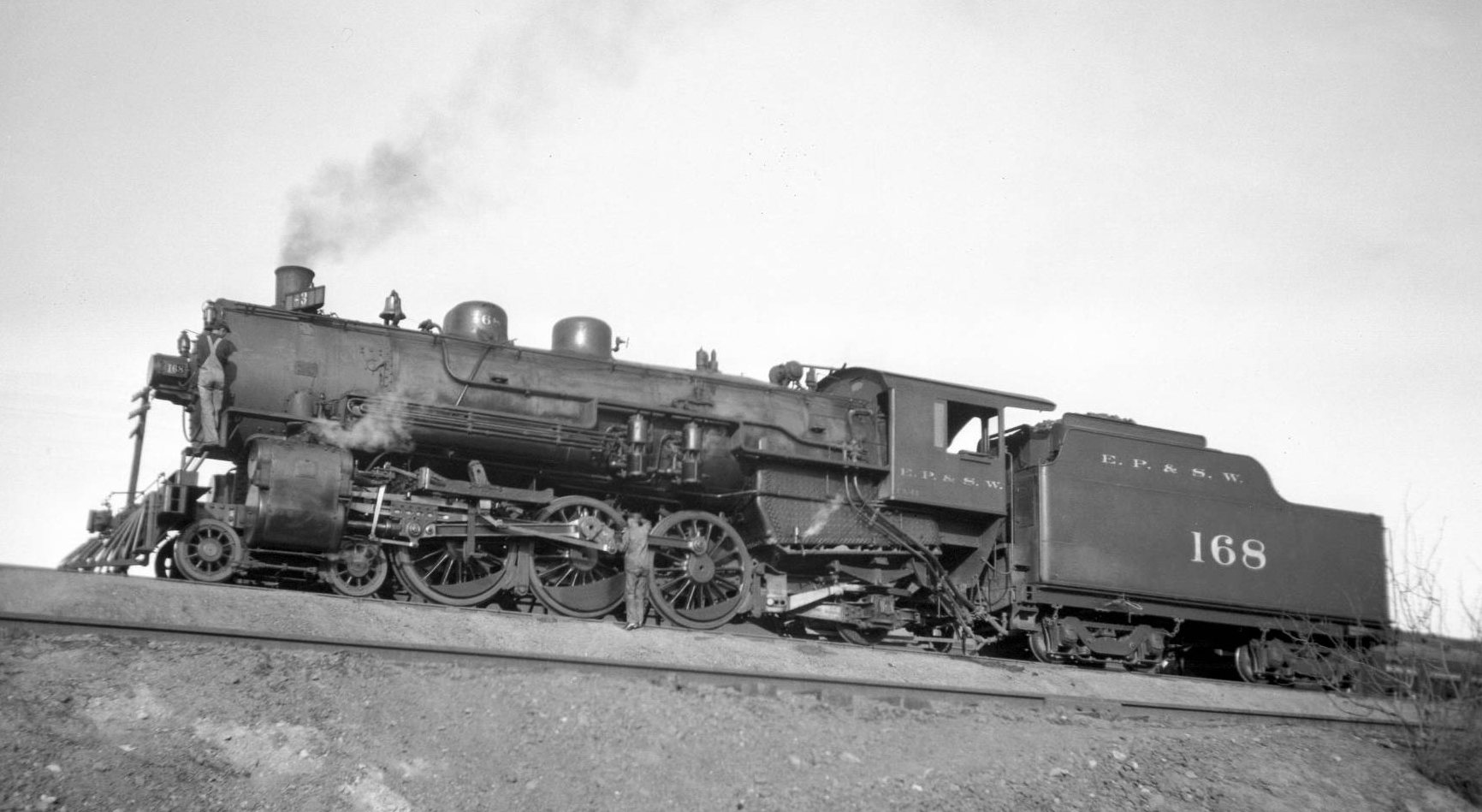 El Paso & Southwestern 4-6-2 #168 is seen here in El Paso, Texas on January 21, 1919. Otto Perry photo.
El Paso & Southwestern 4-6-2 #168 is seen here in El Paso, Texas on January 21, 1919. Otto Perry photo.History
What grew into a 1,000+ mile system started out humbly enough as the Arizona & South Eastern Rail Road chartered in May of 1888 (later known simply as the Arizona & Southeastern Railroad) by the Phelps, Dodge & Company.
The business, which at the time focused on the importation of various metals, had not only discovered large deposits of copper ore in Mule Pass near Bisbee, Arizona but also deposits which were incredibly rich with iron (concentrated at 20% or more).
At first Phelps, Dodge gave no inclination in building its own railroad, instead hoping to lure a railroad such as the Santa Fe or Southern Pacific to build a branch to the area and serve its smelter at Bisbee. Unfortunately, neither road had much interest in such an endeavor and the company decided to forge ahead with its own line.
At A Glance
El Paso, Texas - Tucumcari, New Mexico (Eastern Division) El Paso - Benson, Arizona (Western Division) Osborn - Bisbee, Arizona (Bisbee Branch) Fairbanks - Tombstone, Arizona (Tombstone Branch) Alamogordo, New Mexico - Russia, New Mexico (Alamogordo & Sacramento Mountain Railway) Douglas - Courtland, Arizona (Courtland Branch) Carrizozo - Captain, New Mexico (Captain Branch) Tucumcari - Dawson, New Mexico (Dawson Railway) Hachita - Hermanas - Deming, New Mexico (Deming Branch) Jarilla Junction - Jarilla, New Mexico (Jarilla Branch) | |
After the A&SE was created the new railroad wasted no time in beginning construction opening its initial 36-mile route between Bisbee and Fairbanks the following year in 1889.
At first company officials hoped to establish a connection with the Santa Fe although when an agreement on freight rates could not be agreed upon it was decided that a 19-mile northward extension to Benson would be carried out to reach the SP instead, completed in 1895.
What ultimately began the A&SE's astronomical growth was the coming of electricity around the turn of the century. With the need for copper to transport electricity, naturally demand for the metal grew prodigiously. This resulted in the need for a new smelter, which was built just south of Bisbee.
Logo
Additionally, new deposits were discovered south of the border in Mexico and Phelps, Dodge chartered the Nacozari Rail Road (a subsidiary of the A&SE) in June, 1901 to reach mines at Nacozari which was opened a year later.
The summer of 1901 also witnessed the formation of the El Paso and Southwestern Railroad to take over the operations of the A&SE to better reflect the company's intentions of continuing to expand eastward.
Thanks to a continued growth and demand of copper it was not long before the EP&SW officially opened its extension to El Paso, opening just a year later on December 28, 1902 (unofficially, tracks reached the city on November 19th of that year). Loaded with cash and a desire to continue its expansion the EP&SW more than doubled in size when it took over the El Paso & Northeastern Railroad on July 1, 1905.
System Map (1910)
The EP&N dated to 1896 chartered by Charles Eddy who had purchased the charter of a defunct line that had hoped to do the same, the Denver & El Paso Short Line Railroad.
Under Eddy's control the EP&N slowly trekked northward reach Alamogordo in June of 1898, Carrizozo a year later, and Santa Rosa in 1902 via subsidiary El Paso & Rock Island Railway.
Here, the EP&N established an interchange with the growing Rock Island system and soon after reached Tucumcari via CRI&P trackage rights (it would later outright lease this line from the Rock as of July 1, 1907).
Expansion
Interestingly, enough, the growth did not stop there as the railroad had no more than opened its latest extension when the newly established Dawson Railway was under construction.
This latest development would add 132 miles to the EP&N's operations stretching northwest from Tucumcari and opened in 1903. Before Eddy could continue to expand his growing railroad it was acquired by the EP&SW.
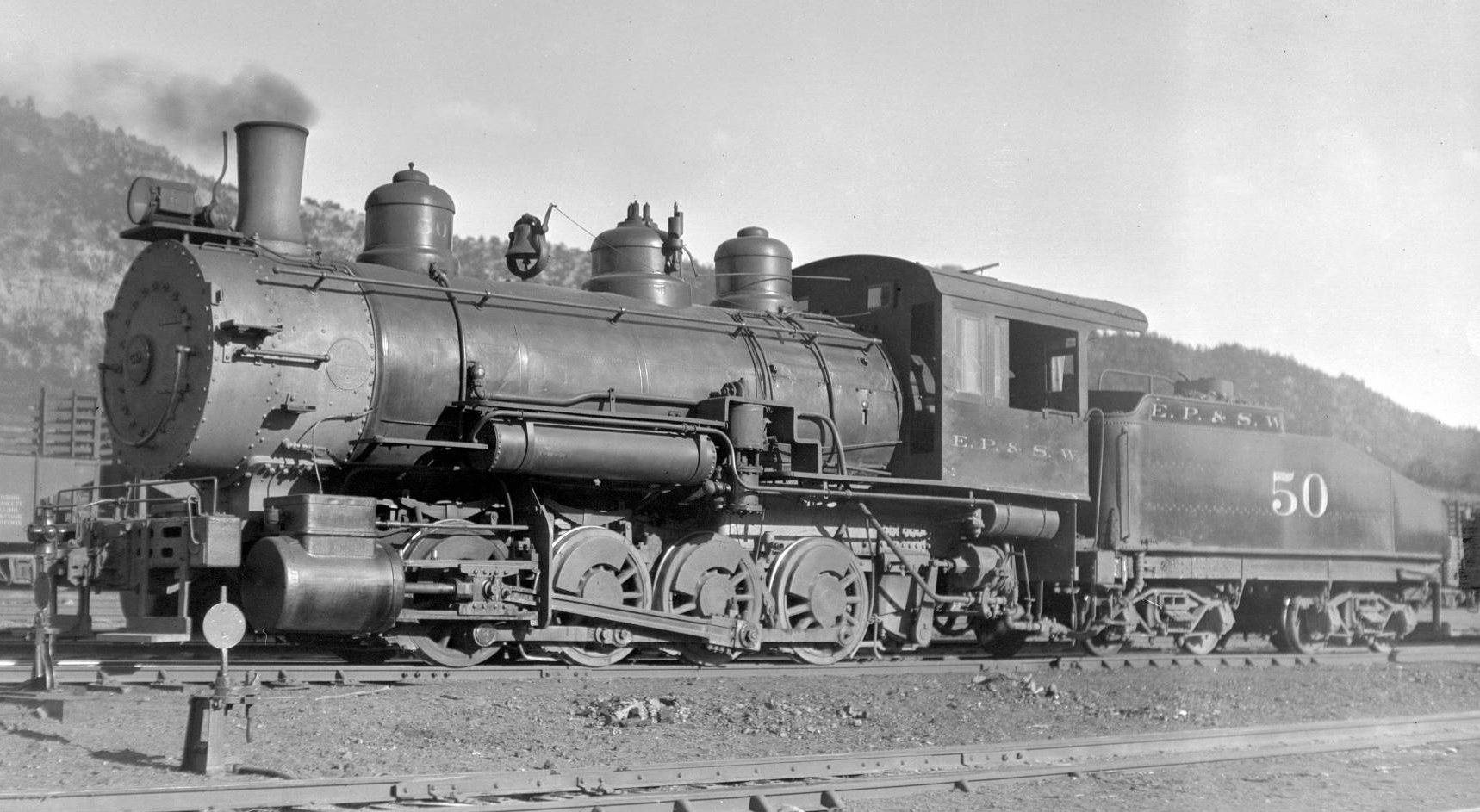 El Paso & Southwestern 0-8-0 switcher #50 is seen here in Dawson, New Mexico on October 18, 1920. Otto Perry photo.
El Paso & Southwestern 0-8-0 switcher #50 is seen here in Dawson, New Mexico on October 18, 1920. Otto Perry photo.With a road that now stretched from eastern Arizona through most of New Mexico the EP&SW was split into Western and Eastern divisions with its base of operations being El Paso.
Over the coming years some expansions continued, mostly in the way of additional branches from its through routes although the road did open a significant 66-mile extension west between Fairbank and Tuscon that began service on November 20, 1912.
With this the EP&SW was mostly complete, boasting a route that covered more than 1,200 miles. Since the company's primary freight was ore it employed a fleet of fairly respectable steam locomotives including heavy 2-8-0 Consolidations, 2-8-2 Mikados, 2-10-0 Decapods, and 4-8-2 Mountains (other wheel arrangements included 2-6-2 Prairies, 2-6-0 Moguls, 4-6-0 ten-wheelers, and 0-6-0/0-8-0 switchers).
Timetables (1910)
Copper, however, was not its only source of freight as the EP&SW also hauled coal, agriculture, livestock, food products, merchandise, and various LCL (less-than-carload) traffic not to mention scheduled passenger trains.
The company's decline, unfortunately, began soon after it reached its peak size. Following World War I the price of copper plummeted forcing mines to close, which of course caused a loss of traffic and reduction in carload value.
Ironically, however, the EP&SW saw an addition during this time when it took over the Arizona & New Mexico Railroad on January 1, 1922 which was sold by parent Arizona Copper Company feeling the affects of the metal's decline.
Southern Pacific Takeover
The A&NM connected to the EP&SW at Hachita, New Mexico reaching as far north as Clifton. With sagging copper prices and the railroad's revenues cut by one-third officials at Phelps, Dodge elected to sell it to Southern Pacific during uncertain times with the deal completed on October 31, 1924 that included stock, bonds, and cash of $64 million.
The transaction also required the Espee to construct a new line to serve Phoenix and provided Phelps, Dodge with terminal property back in Los Angeles. The SP also saw a benefit with The Southwestern Route as it was still a profitable road and also offered the western giant a connection to the Rock Island.
(Thanks to "The Strange Story Of The El Paso & Southwestern" by author David F. Myrick from the February, 1966 issue of Trains as a primary reference for this article.)
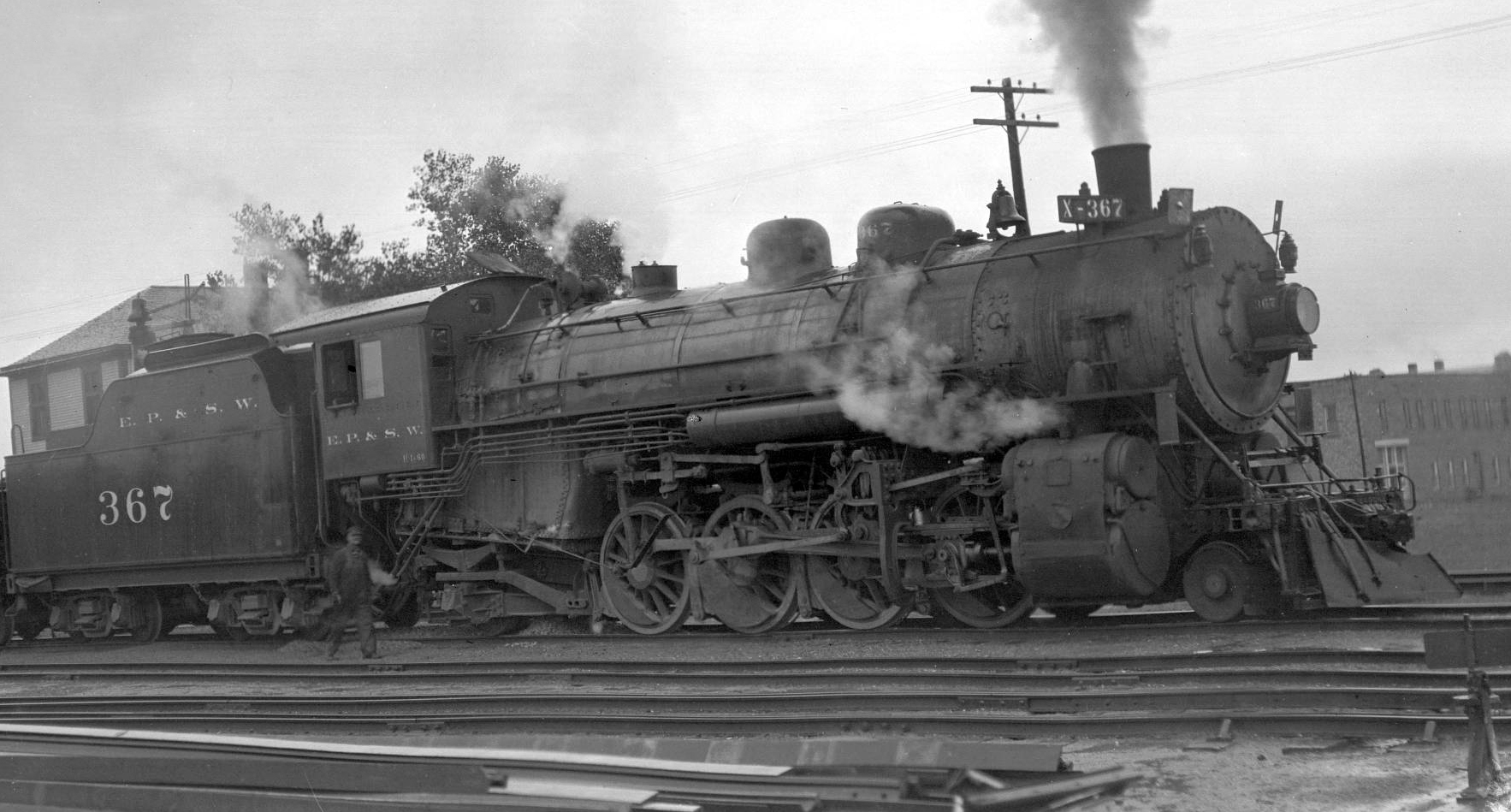 Near the northern edge of the system, El Paso & Southwestern 2-8-2 #367 is seen here in Santa Rosa, New Mexico on October 25, 1920. Otto Perry photo.
Near the northern edge of the system, El Paso & Southwestern 2-8-2 #367 is seen here in Santa Rosa, New Mexico on October 25, 1920. Otto Perry photo.Through the early 1930s the SP's new subsidiary lines continued to earn decent income, interestingly enough, although the Great Depression began to take its toll.
The larger railroad also transferred much heavier power to the property using former Boston & Maine 2-8-4 Berkshires and impressive, brand new 2-8-8-4 Yellowstones acquired from Lima in 1939.
Slowly branches and routes were cut back as copper and coal mines played out, so much so that by the early 1960s the only remaining sections of the EP&SW still in use was the main line between El Paso and Tucumcari as well as a few branches in southern Arizona and New Mexico.
Officially, SP merged the El Paso and Southwestern Railroad into its network in 1961 ending one of the Southwest's largest if relatively unknown Class I systems.
Perhaps most interesting about The Southwestern Route
is at one point it actually was looking to takeover the Rock Island,
purchasing 10% ownership into the Midwest railroad in 1910 (enough to
give it a seat on the board). Ultimately, the holding company created
to oversee the stock failed ending any such possibilities.
Recent Articles
-
Kentucky Dinner Train Rides In Bardstown!
Jan 13, 26 01:14 PM
The essence of My Old Kentucky Dinner Train is part restaurant, part scenic excursion, and part living piece of Kentucky rail history. -
Kansas Dinner Train Rides In Abilene!
Jan 13, 26 12:44 PM
If you’re looking for a heritage railroad that feels authentically Kansas—equal parts prairie scenery, small-town history, and hands-on railroading—the Abilene & Smoky Valley Railroad (A&SV) delivers. -
Michigan ~ Murder Mystery ~ Dinner Train Rides
Jan 13, 26 11:24 AM
Among the lesser-known treasures of this state are the intriguing murder mystery dinner train rides—a perfect blend of suspense, dining, and scenic exploration. -
Virginia's - Murder Mystery - Dinner Train Rides
Jan 13, 26 11:11 AM
Among the state's railroad attractions, murder mystery dinner trains stand out as a captivating fusion of theatrical entertainment, fine dining, and scenic travel. -
Arizona Dinner Train Rides At The Grand Canyon!
Jan 13, 26 10:59 AM
While the Grand Canyon Railway does not offer a true, onboard dinner train experience it does offer several upscale options and off-train dining. -
Georgia Dinner Train Rides In Nashville!
Jan 13, 26 10:27 AM
If you’ve ever wished you could slow down, trade traffic for jointed rail, and let a small-town landscape roll by your window while a hot meal is served at your table, the Azalea Sprinter delivers tha… -
Indiana Valentine's Train Rides
Jan 12, 26 04:27 PM
If you’ve ever wished you could step into a time when passenger trains were a Saturday-night treat and a whistle echoing across farm fields meant “adventure,” the Nickel Plate Express delivers that fe… -
Ohio Valentine's Train Rides!
Jan 12, 26 04:20 PM
The Hocking Valley Scenic Railway offers one of the region’s most atmospheric ways to experience the Hocking Hills area: from the rhythmic click of jointed rail to the glow of vintage coaches rolling… -
Wisconsin's - Wine Tasting - Train Rides
Jan 12, 26 03:10 PM
Wisconsin might not be the first state that comes to mind when one thinks of wine, but this scenic region is increasingly gaining recognition for its unique offerings in viticulture. -
California's - Wine Tasting - Train Rides
Jan 12, 26 02:34 PM
This article explores the charm, routes, and offerings of these unique wine tasting trains that traverse California’s picturesque landscapes. -
Wisconsin Scenic Train Rides In North Freedom!
Jan 12, 26 02:20 PM
The Mid-Continent Railway Museum is a living-history museum built around the sights, sounds, and everyday rhythms of small-town and shortline railroading in the early 20th century, what the museum cal… -
Vermont Scenic Train Rides In Burlington!
Jan 12, 26 01:18 PM
Today, GMRC is best known by many travelers for its Burlington-based passenger experiences—most famously the Champlain Valley Dinner Train and the sleek, limited-capacity Cocktails on the Rails. -
Maryland's - Murder Mystery - Dinner Train Rides
Jan 12, 26 01:03 PM
Maryland is known for its scenic landscapes, historical landmarks, and vibrant culture, but did you know that it’s also home to some of the most thrilling murder mystery dinner trains? -
Minnesota's - Murder Mystery - Dinner Train Rides
Jan 12, 26 12:17 PM
Murder mystery dinner trains offer an enticing blend of suspense, culinary delight, and perpetual motion, where passengers become both detectives and dining companions on an unforgettable journey. -
Vermont Dinner Train Rides In Burlington!
Jan 12, 26 12:09 PM
There is one location in Vermont hosting a dedicated dinner train experience at the Green Mountain Railroad. -
Connecticut Dinner Train Rides In Essex!
Jan 12, 26 10:39 AM
Connecticut's rail heritage can be traced back to the industry's earliest days and a few organizations preserve this rich history by offering train rides. The Essex Steam Train also hosts dinner-theme… -
Florida Scenic Train Rides In Parrish!
Jan 11, 26 10:26 PM
The Florida Railroad Museum (FRRM) in Parrish offers something increasingly rare in today’s rail landscape: a chance to ride historic equipment over a surviving fragment of an early-20th-century mainl… -
California's - Wine Tasting - Train Rides
Jan 11, 26 02:28 PM
This article explores the charm, routes, and offerings of these unique wine tasting trains that traverse California’s picturesque landscapes. -
Georgia's - Murder Mystery - Dinner Train Rides
Jan 11, 26 02:07 PM
In the heart of the Peach State, a unique form of entertainment combines the thrill of a murder mystery with the charm of a historic train ride. -
Colorado ~ Murder Mystery ~ Dinner Train Rides
Jan 11, 26 01:43 PM
Nestled among the breathtaking vistas and rugged terrains of Colorado lies a unique fusion of theater, gastronomy, and travel—a murder mystery dinner train ride. -
Minnesota Dinner Train Rides In Duluth!
Jan 11, 26 01:32 PM
One of the best ways to feel the region's history in motion today is aboard the North Shore Scenic Railroad (NSSR), which operates out of Duluth’s historic depot. -
Illinois Dinner Train Rides At Monticello!
Jan 11, 26 12:42 PM
The Monticello Railway Museum (MRM) is one of those places that quietly does a lot: it preserves a sizable collection, maintains its own operating railroad, and—most importantly for visitors—puts hist… -
Alabama's - Wine Tasting - Train Rides
Jan 10, 26 09:29 AM
While the state might not be the first to come to mind when one thinks of wine or train travel, the unique concept of wine tasting trains adds a refreshing twist to the Alabama tourism scene. -
Maryland Dinner Train Rides At WMSR!
Jan 10, 26 09:13 AM
The Western Maryland Scenic Railroad (WMSR) has become one of the Mid-Atlantic’s signature heritage operations—equal parts mountain railroad, living museum, and “special-occasion” night out. -
Arkansas Dinner Train Rides On The A&M!
Jan 10, 26 09:11 AM
If you want a railroad experience that feels equal parts “working short line” and “time machine,” the Arkansas & Missouri Railroad (A&M) delivers in a way few modern operations can. -
South Dakota's - Murder Mystery - Dinner Train Rides
Jan 10, 26 09:08 AM
While the state currently does not offer any murder mystery dinner train rides, the popular "1880 Train" at the Black Hills Central recently hosted these popular trips! -
Wisconsin's - Murder Mystery - Dinner Train Rides
Jan 10, 26 09:07 AM
Whether you're a fan of mystery novels or simply relish a night of theatrical entertainment, Wisconsin's murder mystery dinner trains promise an unforgettable adventure. -
Missouri's - Murder Mystery - Dinner Train Rides
Jan 10, 26 09:05 AM
Missouri, with its rich history and scenic landscapes, is home to one location hosting these unique excursion experiences. -
Washington ~ Murder Mystery ~ Dinner Train Rides
Jan 10, 26 09:04 AM
This article delves into what makes murder mystery dinner train rides in Washington State such a captivating experience. -
Kentucky Scenic Train Rides At KRM!
Jan 09, 26 11:13 PM
Located in the small town of New Haven the Kentucky Railway Museum offers a combination of historic equipment and popular excursions. -
Washington "Wine Tasting" Train Rides
Jan 09, 26 08:53 PM
Here’s a detailed look at where and how to ride, what to expect, and practical tips to make the most of wine tasting by rail in Washington. -
Kentucky's - Wine Tasting - Train Rides
Jan 09, 26 08:21 PM
Kentucky, often celebrated for its rolling pastures, thoroughbred horses, and bourbon legacy, has been cultivating another gem in its storied landscapes; enjoying wine by rail. -
Kentucky's - Murder Mystery - Dinner Train Rides
Jan 09, 26 01:12 PM
In the realm of unique travel experiences, Kentucky offers an enchanting twist that entices both locals and tourists alike: murder mystery dinner train rides. -
Utah's - Murder Mystery - Dinner Train Rides
Jan 09, 26 01:05 PM
This article highlights the murder mystery dinner trains currently avaliable in the state of Utah! -
North Carolina Dinner Train Rides At NCTM!
Jan 09, 26 12:51 PM
Tucked into the Piedmont town of Spencer, the North Carolina Transportation Museum is the kind of place that feels less like a typical museum and more like a living rail yard that never quite stopped… -
Tennessee Dinner Train Rides At The TVRM!
Jan 09, 26 12:39 PM
Tucked into East Chattanooga, the Tennessee Valley Railroad Museum (TVRM) is less a “museum you walk through” and more a railroad you step aboard. -
New York Scenic Train Rides On The A&A!
Jan 09, 26 11:20 AM
The A&A is both a common-carrier short line moving freight and a heritage railroad hosting popular excursion trains, all on the same storied right-of-way. -
Pennsylvania Scenic Train Rides In Hollidaysburg!
Jan 09, 26 11:14 AM
Tucked into the Juniata River valley just south of Altoona, the Everett Railroad offers one of the most approachable—and photogenic—heritage-rail experiences in Pennsylvania -
Montana Dinner Train Rides Near Lewistown!
Jan 08, 26 03:03 PM
The Charlie Russell Chew Choo turns an ordinary rail trip into an evening event: scenery, storytelling, live entertainment, and a hearty dinner served as the train rumbles across trestles and into a t… -
Alabama's - Murder Mystery - Dinner Train Rides
Jan 08, 26 02:19 PM
There is currently one location in the state offering a murder mystery dinner experience, the Wales West Light Railway! -
Rhode Island's - Murder Mystery - Dinner Train Rides
Jan 08, 26 01:43 PM
Let's dive into the enigmatic world of murder mystery dinner train rides in Rhode Island, where each journey promises excitement, laughter, and a challenge for your inner detective. -
Florida's - Wine Tasting - Train Rides
Jan 08, 26 01:13 PM
Wine by train not only showcases the beauty of Florida's lesser-known regions but also celebrate the growing importance of local wineries and vineyards. -
Texas's - Wine Tasting - Train Rides
Jan 08, 26 12:30 PM
This article invites you on a metaphorical journey through some of these unique wine tasting train experiences in Texas. -
New York's - Wine Tasting - Train Rides
Jan 08, 26 11:32 AM
This article will delve into the history, offerings, and appeal of wine tasting trains in New York, guiding you through a unique experience that combines the romance of the rails with the sophisticati… -
California Dinner Train Rides In Sacramento!
Jan 08, 26 11:21 AM
Just minutes from downtown Sacramento, the River Fox Train has carved out a niche that’s equal parts scenic railroad, social outing, and “pick-your-own-adventure” evening on the rails. -
New Jersey Dinner Train Rides In Woodstown!
Jan 08, 26 10:31 AM
For visitors who love experiences (not just attractions), Woodstown Central’s dinner-and-dining style trains have become a signature offering—especially for couples’ nights out, small friend groups, a… -
Nevada's - Murder Mystery - Dinner Train Rides
Jan 07, 26 02:12 PM
Seamlessly blending the romance of train travel with the allure of a theatrical whodunit, these excursions promise suspense, delight, and an unforgettable journey through Nevada’s heart. -
West Virginia's - Murder Mystery - Dinner Train Rides
Jan 07, 26 02:08 PM
For those looking to combine the allure of a train ride with an engaging whodunit, the murder mystery dinner trains offer a uniquely thrilling experience. -
Kansas's - Murder Mystery - Dinner Train Rides
Jan 07, 26 01:53 PM
Kansas, known for its sprawling wheat fields and rich history, hides a unique gem that promises both intrigue and culinary delight—murder mystery dinner trains. -
Michigan's - Wine Tasting - Train Rides
Jan 07, 26 12:36 PM
In this article, we’ll delve into the world of Michigan’s wine tasting train experiences that cater to both wine connoisseurs and railway aficionados.

